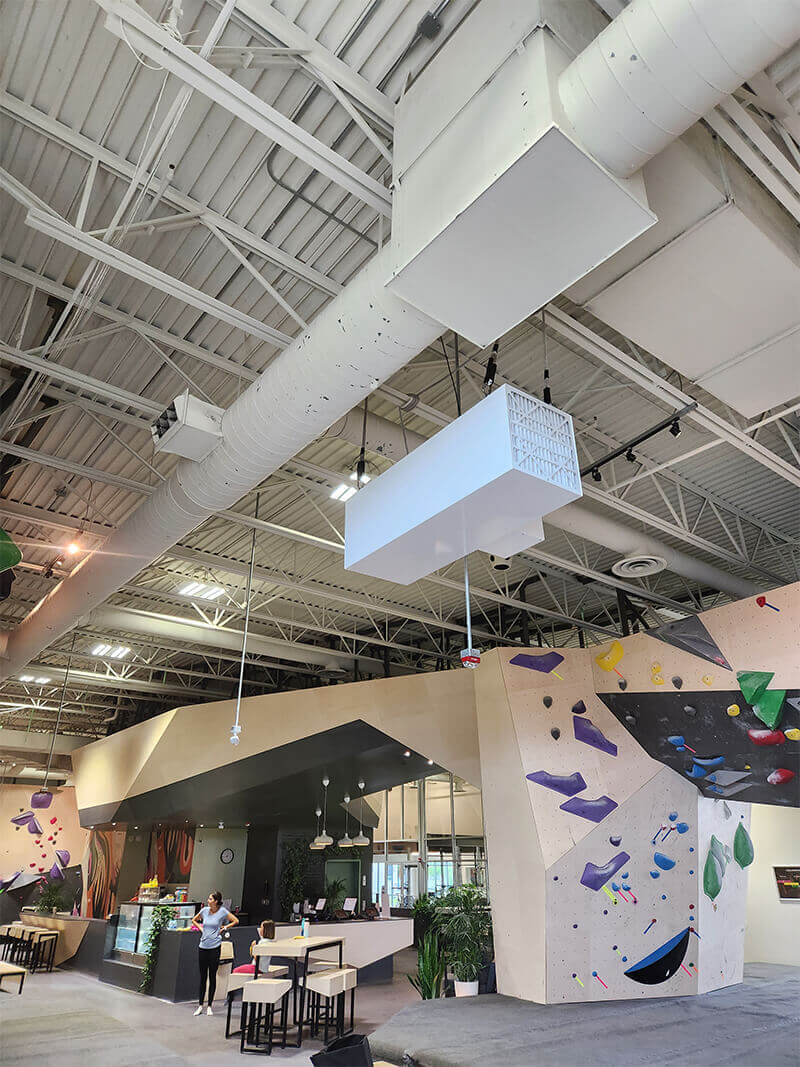
Filter Replacement Schedules: Optimizing Performance & Cost
For businesses that rely on commercial or industrial air filtration systems, finding the optimal filter replacement schedule is crucial. Replace filters too early, and you're wasting money on unnecessary replacements.
Wait too long, and you risk decreased system performance, higher energy costs, and potentially compromised air quality.
Blue Ox Air Cleaners are designed to deliver maximum filtration efficiency while minimizing operating costs — but achieving this balance requires understanding the proper maintenance schedule for your specific application and filtration configuration.
Filter Lifespan by Configuration Type
Each Blue Ox filtration configuration has different replacement requirements based on the filter types used and the contaminants being captured. Here's a breakdown of general replacement guidelines by configuration:
General Use Systems
1" Pleated Pre-filter: Replace every 1-3 months
Pocket Bag Filter (65% or 95%): Replace every 6-12 months
Key indicators for replacement: Visible dust accumulation on pre-filter, decreased airflow, or increase in static pressure readings.
Carbon Filter (CF) — Light Odor Control
1" or 4" Pleated Pre-filter: Replace every 1-3 months
Pocket Bag Filter (65% or 95%): Replace every 6-12 months
2" Charcoal Afterfilter: Replace every 3-6 months (depending on odor load)
Key indicators for replacement: Noticeable reduction in odor control efficiency, breakthrough odors, or when charcoal media appears saturated.
Carbon Module (CC) — Extra Odor Control
1" or 4" Pleated Pre-filter: Replace every 1-3 months
95% Pocket Bag Filter: Replace every 6-12 months
18 lb or 36 lb Carbon Module: Replace every 6-12 months (varies by contaminant load)
Key indicators for replacement: Return of noticeable odors in the space, decreased efficiency in odor control, or when carbon has reached saturation point.
HEPA (HE) — Clean Room Use
1" or 4" Pleated Pre-filter: Replace every 1-2 months
95% Pocket Bag Filter: Replace every 6-9 months
99.97% HEPA Afterfilter: Replace every 12-24 months
Key indicators for replacement: Any decline in required air quality standards, increased particulate levels in testing, or significant pressure drop across the HEPA filter.
Wrap-Around Filter (WA/WAL/WAR) — Large Particulate
Wrap-Around Fiber Pre-filter: Clean every 2-4 weeks, replace when fiber deteriorates
4" Pleated Pre-filter: Replace every 2-4 months
65% Bag Filter: Replace every 6-12 months
Key indicators for replacement: Heavy dust accumulation that cannot be removed through cleaning, visible damage to filter media, or decreased airflow.
Factors That Affect Filter Lifespan
Several factors can significantly impact how frequently filters will need to be replaced:
Contaminant Type and Concentration
Heavy dust environments (woodshops, metalworking) require more frequent pre-filter changes
Strong odors (cigar lounges, cannabis facilities) accelerate carbon saturation
Finer particulates (welding fumes) may penetrate pre-filters faster, shortening bag filter life
Operating Hours
• Systems running 24/7 will require more frequent replacements than those used only during business hours
• Consider tracking actual operating hours rather than calendar time for more accurate replacement scheduling
Airflow Settings
• Higher CFM settings increase the volume of air (and contaminants) passing through filters
• Running at maximum capacity will shorten filter life compared to lower settings
Environmental Factors
• Humidity levels can affect carbon filter efficiency and lifespan
• Seasonal changes may introduce different pollutant levels (pollen in spring, wildfire smoke in summer)
• Temperature fluctuations can impact filter performance and longevity
Optimizing Your Replacement Schedule for Cost Efficiency
Progressive Filtration Strategy
Blue Ox Air Cleaners use a multi-stage filtration approach where each filter protects the next in line. By closely monitoring and replacing pre-filters on schedule, you extend the life of more expensive downstream filters:
Pre-filters (least expensive) capture larger particles and should be replaced most frequently
Bag filters (moderately expensive) capture finer particles and have a longer lifespan when pre-filters are maintained
Specialty filters (HEPA or carbon modules - most expensive) last significantly longer when protected by properly maintained pre-filters and bag filters
Cost-Saving Approaches
Filter Monitoring Methods
Visual inspections: Regularly check pre-filters for dust accumulation
Pressure differential monitoring: Install magnehelic gauges to measure pressure drop across filters
Air quality testing: Periodic testing can confirm system performance and prevent premature replacements
Maintenance logs: Track replacement dates and correlation with air quality to establish optimal patterns
Advanced Planning
Bulk purchasing: Order commonly replaced filters (especially pre-filters) in quantity for volume discounts
Preventative maintenance contracts: Consider service agreements that include regular filter replacements at scheduled intervals
Filter inventory management: Maintain a stock of essential filters to avoid emergency purchases
Application-Specific Recommendations
Cigar Lounges and Smoking Areas
• Pre-filters may need replacement every 2-4 weeks
• Carbon modules should be monitored closely for breakthrough odors
• Consider rotating carbon modules (front to back) to maximize carbon utilization
Woodworking and Manufacturing
• Wrap-around pre-filters should be cleaned weekly in high-dust environments
• Consider implementing a compressed air cleaning schedule for washable filters
• Monitor filter pressure drops closely as dust accumulation can rapidly reduce airflow
Clean Rooms and Healthcare
• Maintain strict replacement schedules regardless of visual indicators
• Document all filter changes as part of compliance protocols
• Consider more frequent replacement during high-use periods or disease outbreaks
Welding and Metalworking
• Monitor pre-filters closely as metal particulate can quickly accumulate
• Be alert for any metal dust penetration to secondary filters
• Consider custom replacement schedules based on production volume
Implementing a Filter Management Program
Establish Baseline Measurements
• Document initial pressure readings across each filter when newly installed
• Set threshold values that trigger replacement (typically 1-2" w.g. pressure increase)
• Record initial air quality metrics for comparison
Create a Monitoring Schedule
Daily: Visual check of pre-filters in high-concentration environments
Weekly: Brief system performance check (airflow, noise levels, odor control)
Monthly: Thorough filter inspection and pressure differential measurements
Quarterly: Complete system evaluation and filter replacement as needed
Train Maintenance Personnel
• Proper filter handling procedures to avoid contamination
• Correct installation techniques to prevent bypass air
• How to recognize signs of filter saturation or failure
Document Everything
• Filter change dates
• Performance measurements before and after changes
• Notes on visual condition of removed filters
• Any relevant environmental factors (increased production, seasonal changes)
Return on Investment Analysis
Implementing an optimized filter replacement schedule provides measurable ROI:
Extended equipment life: Properly maintained filtration systems last longer
Reduced energy consumption: Clean filters require less fan power to maintain airflow
Lower replacement costs: Maximizing filter life reduces annual filter expenses
Maintained productivity: Consistent air quality supports employee health and comfort
Regulatory compliance: Documented maintenance helps meet air quality requirements
Optimizing filter replacements is a balancing act between maintaining peak air quality and controlling operational costs. By understanding your specific application needs, monitoring system performance, and implementing a structured maintenance program, you can achieve both objectives.
Blue Ox Air Cleaners are designed to deliver years of reliable service with proper maintenance. Our filtration specialists are available to help you develop a customized replacement schedule for your specific application and environment.
For personalized assistance with your filter replacement strategy or to order replacement filters, contact our team of specialists. We're here to help ensure your air quality solution continues to perform at its best while minimizing your maintenance costs.
You may also like:
• What is Indoor Air Quality (IAQ) & How Does It Apply to You?
• The Difference Between Air Filtration & Ventilation
• 7 Reasons to Choose Blue Ox Air Cleaners
Copyright © 2025 | Blue Ox Air Cleaners. A division of Air Cleaning Specialists, Inc.


